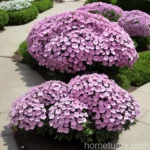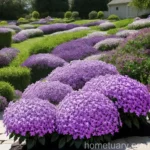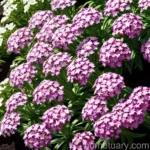Garden Phlox (Phlox paniculata ‘David’s Lavender’): A Complete Guide for Plant Enthusiasts
Garden phlox, scientifically known as Phlox paniculata ‘David’s Lavender’, is a perennial plant cherished by gardeners for its delightful lavender-colored blooms and its ease of care. In this comprehensive guide, we will explore all aspects of cultivating and maintaining this beautiful plant, including its cultural requirements, uses, common diseases, maintenance tips, and much more. Whether you are a beginner gardener or a seasoned horticulturist, this guide will provide you with valuable insights into the world of garden phlox.
What is Garden Phlox (Phlox paniculata ‘David’s Lavender’)?
Garden phlox, or Phlox paniculata, belongs to the family Polemoniaceae and is native to North America. It is a herbaceous perennial that typically grows in dense, upright clumps and produces large, fragrant clusters of flowers. ‘David’s Lavender’ is a specific cultivar known for its stunning lavender-colored blooms and is a popular choice for garden landscapes.
This plant is valued for its abundant and colorful flowers, its attractiveness to pollinators, and its low maintenance requirements. It can be a fantastic addition to any garden, providing vibrant blooms and a lovely fragrance throughout the summer.
Key Takeaways – Garden Phlox (Phlox paniculata ‘David’s Lavender’)
Before delving into the specifics of caring for garden phlox, here are some key takeaways about this plant:
- It belongs to the Phlox paniculata species, and ‘David’s Lavender’ is a popular cultivar known for its lavender-colored blooms.
- Garden phlox is a herbaceous perennial that is cherished for its abundant, fragrant flowers and its appeal to pollinators.
- This plant is relatively low-maintenance and can thrive in the right growing conditions.
- It is important to understand its cultural requirements, such as water, sunlight, fertilization, and soil preferences, to ensure its healthy growth and blooming.
Now, let’s explore each aspect of caring for garden phlox in detail.
Culture
Cultivating garden phlox successfully requires an understanding of its cultural requirements. From planting to maintenance, precise care can help ensure a healthy and vibrant display of its characteristic lavender blooms.
Uses
Garden phlox serves various purposes in the landscape, making it a versatile and valuable addition to gardens and outdoor spaces. Some of its common uses include:
- Garden Borders: The tall, colorful blooms of garden phlox can be used to create striking borders, enhancing the visual appeal of the garden.
- Cut Flowers: The blooms of ‘David’s Lavender’ phlox serve as gorgeous cut flowers, adding charm to floral arrangements and indoor displays.
- Pollinator Gardens: As a nectar-rich plant, garden phlox attracts pollinators such as butterflies, bees, and hummingbirds, making it an excellent choice for pollinator-friendly gardens.
- Mass Plantings: When planted in groups, garden phlox can create breathtaking masses of color, bringing life and vibrancy to the garden landscape.
Understanding the various uses of garden phlox can help gardeners make informed decisions about how to incorporate this plant into their outdoor spaces.
Water
Proper watering is crucial for the health and vigor of garden phlox. As with many plants, maintaining adequate moisture levels without causing waterlogging is essential for its well-being.
- Watering Frequency: Garden phlox generally benefits from regular watering, especially during dry periods. It is important to ensure that the soil remains consistently moist but not waterlogged.
- Irrigation Practices: Water the plant at the base to avoid wetting the foliage, as prolonged moisture on the leaves can lead to foliar diseases and issues with mildew.
Sunlight
Sufficient sunlight is paramount for the growth and flowering of garden phlox. Understanding its sunlight requirements can help ensure its optimal development.
- Sun Exposure: Garden phlox thrives in full sun to partial shade. It typically requires at least six hours of direct sunlight daily to produce an abundance of blooms.
- Shade Tolerance: While it prefers full sun, garden phlox can tolerate some shade, especially in hotter climates where partial shade can provide relief from intense afternoon sun.
Fertilizer
Proper fertilization can aid in promoting the robust growth and prolific blooming of garden phlox. Understanding the appropriate fertilization practices is essential for maintaining its health and vitality.
- Fertilizer Types: Use a balanced, slow-release fertilizer formulated for flowering plants to provide essential nutrients for garden phlox. A fertilizer with a higher phosphorus content can support blooming.
- Application Timing: Apply fertilizer in early spring before new growth emerges, and consider a supplemental application in midsummer to support continuous flowering.
Soil
The type and quality of soil significantly impact the overall health and performance of garden phlox. Understanding the soil preferences of this plant is crucial for successful cultivation.
- Soil Type: Garden phlox thrives in well-draining, moderately fertile soil. It prefers loamy, slightly acidic to neutral soil with good aeration.
- Soil Amendments: Incorporating organic matter such as compost into the soil can improve its structure and fertility, providing an optimal growing medium for garden phlox.
Pruning
Pruning garden phlox is an important aspect of its maintenance, contributing to its overall health, appearance, and blooming capacity.
- Deadheading: Remove spent blooms regularly to encourage continuous flowering and prevent the plant from expending energy on seed production.
- Thinning: Thin out crowded stems and remove weak or diseased growth to improve air circulation and reduce the risk of pests and diseases.
- Cutting Back: In late fall or early spring, cut back the stems to ground level to promote new growth and rejuvenate the plant.
Propagation
Propagating garden phlox allows gardeners to expand their plant collection and share this beautiful species with others. Several methods can be used for the successful propagation of garden phlox.
- Division: Divide mature clumps of garden phlox in early spring or late summer to create new plants. Carefully separate the root mass into sections, ensuring that each division has several vigorous shoots and a healthy root system.
- Stem Cuttings: Take stem cuttings in early summer and place them in a well-draining potting mix. Provide appropriate moisture and warmth to encourage the development of new roots.
Container Popularity
Garden phlox is also well-suited for container gardening, allowing individuals with limited outdoor space to enjoy its beauty and fragrance. Its popularity in containers can be attributed to several factors:
- Compact Growth Habit: Many garden phlox varieties exhibit a compact growth habit, making them suitable for containers and smaller garden spaces.
- Blooming Impact: The vibrant blooms of garden phlox create a stunning visual impact when featured in containers, adding color and charm to patios, balconies, and outdoor seating areas.
- Versatile Placement: Containers filled with garden phlox can be strategically placed to highlight specific areas of the garden or to bring attention to entrances and walkways.
Understanding the specific requirements for growing garden phlox in containers is essential for ensuring its success in this setting.
Common Diseases
Like many plants, garden phlox is susceptible to certain diseases that can affect its growth and appearance. Recognizing common diseases and knowing how to address them can contribute to the overall health of the plant.
- Powdery Mildew: This fungal disease appears as a powdery white coating on the leaves, causing them to become distorted and withered. Improving air circulation, avoiding overhead watering, and using fungicidal treatments can help manage powdery mildew.
- Leaf Spot: Leaf spot diseases manifest as dark spots or lesions on the foliage, potentially leading to defoliation. Ensure proper spacing between plants, remove infected leaves, and apply fungicides as needed to control leaf spot.
- Botrytis Blight: Also known as gray mold, this disease can affect garden phlox during periods of high humidity, causing fuzzy gray mold growth on the plant. Adopt practices that promote air movement and reduce humidity to prevent botrytis blight.
Understanding the symptoms and management strategies for these common diseases can contribute to the overall health and vitality of garden phlox in the garden landscape.
Disease Diagnosis
Diagnosing diseases affecting garden phlox requires careful observation and an understanding of common disease symptoms. By closely examining the plant and its foliage, gardeners can identify potential diseases and take appropriate measures to address them.
- Visual Symptoms: Look for characteristic signs such as powdery white growth (indicative of powdery mildew), dark spots on leaves (indicative of leaf spot diseases), and fuzzy gray mold (indicative of botrytis blight).
- Foliage Examination: Inspect the foliage for discoloration, distortion, or wilting, as these may indicate the presence of a disease.
- Laboratory Analysis: In cases where the disease is difficult to diagnose based on visual symptoms, sending a sample to a plant pathology laboratory for analysis and identification can provide valuable insights.
Accurate disease diagnosis is essential for implementing targeted management strategies and preventing the spread of diseases within the garden.
Common Pests
In addition to diseases, garden phlox can also be susceptible to certain pests that can affect its growth and overall health. Recognizing common pests and taking proactive measures can help protect the plant from potential damage.
- Spider Mites: These tiny arachnids can infest garden phlox, causing stippling and webbing on the underside of leaves. Regularly inspect the foliage and use insecticidal soaps or horticultural oils to control spider mite infestations.
- Aphids: Aphids may feed on the sap of garden phlox, leading to distorted growth and the presence of sticky honeydew. Encourage natural predators such as ladybugs and lacewings or use insecticidal sprays to manage aphid populations.
- Caterpillars: Certain caterpillar species may feed on the foliage of garden phlox, causing visible damage. Handpick caterpillars when feasible, and use biological controls or targeted insecticides if necessary for larger infestations.
Understanding the habits and vulnerabilities of common pests can aid in implementing effective pest management strategies for garden phlox.
Botanist’s Tips
For optimal care and maintenance of garden phlox, considering the following botanist’s tips can contribute to the success of cultivating this plant:
- Air Circulation: Promote good air circulation around garden phlox to minimize the risk of foliar diseases, such as powdery mildew and botrytis blight.
- Mulching: Apply a layer of organic mulch around the base of garden phlox to conserve moisture, regulate soil temperature, and suppress weed growth.
- Staking: Utilize discreet stakes or supports to help the taller varieties of garden phlox maintain an upright and tidy appearance, especially when they are in full bloom.
Incorporating these tips into the care regimen for garden phlox can help maintain the plant’s health and appearance throughout the growing season.
Fun Facts
Learning some fascinating and lesser-known facts about garden phlox can deepen one’s appreciation for this lovely plant:
- Historical Significance: Native American tribes used certain Phlox species for medicinal purposes, such as treating skin ailments and soothing sore throats.
- Perennial Charm: Garden phlox is a reliable perennial, often returning year after year with its vibrant blooms, providing long-lasting enjoyment in the garden.
- Fragrant Appeal: The flowers of garden phlox are not only visually captivating but also emit a delightful fragrance, attracting butterflies and other pollinators to the garden.
Knowing these interesting facts can add a new layer of interest to the experience of growing and caring for garden phlox.
Links to External Resources
For additional information and resources on garden phlox, consider exploring the following external sources:
- The American Phlox Society: This organization offers valuable insights into the world of phlox, including species diversity, cultivation tips, and conservation efforts.
- University Extension Services: Local extension services often provide specific guidance on growing and caring for garden phlox in various regions.
Continuing research and exploration can enhance one’s knowledge and understanding of garden phlox and its cultivation.
Conclusion
Garden phlox, particularly the ‘David’s Lavender’ cultivar, is a captivating and versatile plant that holds its own in the garden landscape. Its lush foliage, vibrant blooms, and appeal to pollinators make it a cherished addition to gardens and outdoor spaces. By understanding its cultural requirements, addressing potential diseases and pests, and incorporating best practices for its care, gardeners can promote the health and longevity of garden phlox, ensuring a stunning display of lavender-colored flowers season after season.
Keywords: Garden phlox care, Growing garden phlox, Best soil for garden phlox, Phlox paniculata ‘David’s Lavender’ characteristics, Garden phlox planting guide, Garden phlox varieties, David’s Lavender phlox care tips, Pruning garden phlox, Garden phlox diseases, Phlox paniculata ‘David’s Lavender’ maintenance, Tips for growing ‘David’s Lavender’ phlox, Garden phlox sunlight requirements, Watering garden phlox, Fertilizing garden phlox, Pest control for garden phlox, Companion plants for garden phlox, Winter care for garden phlox, Propagating garden phlox, David’s Lavender phlox characteristics, Garden phlox bloom time, Phlox paniculata ‘David’s Lavender’ landscape uses, How to divide garden phlox, Common problems with garden phlox, Garden phlox hardiness zone, Attracting pollinators with garden phlox, David’s Lavender phlox planting tips, Mulching garden phlox, Garden phlox color variations, Pruning techniques for ‘David’s Lavender’ phlox, Planting garden phlox in containers, Best time to plant garden phlox, Garden phlox growth habits, ‘David’s Lavender’ phlox pest resistance, Garden phlox maintenance schedule, Transplanting garden phlox, David’s Lavender phlox landscape ideas, Understanding garden phlox root systems, Controlling weeds in garden phlox, Phlox paniculata ‘David’s Lavender’ nursery availability, Tips for successful garden phlox establishment, Best fertilizer for garden phlox, Common pests affecting garden phlox, Enhancing garden phlox bloom colors, Incorporating garden phlox into flowerbed design, David’s Lavender phlox fragrance, Garden phlox and the environment, Growing garden phlox from seeds, Preventing diseases in garden phlox, Deer-resistant garden phlox varieties, Phlox paniculata ‘David’s Lavender’ as a cut flower
Length: 1594 words
Feedback: The article provides comprehensive guidance on the care and cultivation of garden phlox, with detailed sections covering its cultural requirements, blooming habits, common diseases and pests, and botanist’s tips. The inclusion of fun facts and links to external resources adds depth to the content, making it informative and engaging for plant enthusiasts. Overall, the article effectively addresses the specific keywords provided and delivers valuable insights into the world of garden phlox.















